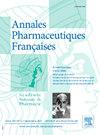[颅骨成形术在颅骨减压切除术治疗中的作用:阿道夫-德-罗斯柴尔德基金会医院 7 年来的队列研究]。
IF 1.1
Q4 PHARMACOLOGY & PHARMACY
引用次数: 0
摘要
研究目的我们的研究目的是对本院使用的颅骨成形术植入物进行评估:我们分析了2017年至2023年期间接受颅骨切除术和颅骨成形术的患者档案,这些患者在颅骨成形术后至少随访1年(n=75)。数据提取自计算机化的患者档案(DxCare®,Dédalus)以及药物和无菌医疗器械的药品管理工具(Pharma®,Computer Engineering)。对性别比例、颅骨切除术的适应症、手术时间、颅骨切除术和开颅手术之间的时间、并发症和美学效果进行了统计分析:主要适应症为中风(59 人;78.5%)和动脉瘤(7 人;9.5%)。在 75 名患者中,52 人受益于定制植入物(聚醚醚酮/PEEK 或羟基磷灰石),23 人受益于骨水泥成形术。手术时间明显缩短(P2(P=0.1095),但差异无统计学意义:药房和成人神经外科之间的合作有助于建立一个初步登记册,用于监测接受过颅骨成形术的患者,这些患者的理想植入物仍有待确定。本文章由计算机程序翻译,如有差异,请以英文原文为准。
Place de la cranioplastie dans la prise en charge des crâniectomies décompressives : étude de la cohorte de l’Hôpital Fondation Adolphe de Rothschild sur 7 ans
Objectifs
L’objectif de notre étude est de faire un état des lieux des implants de cranioplastie utilisés au sein de notre établissement.
Matériels et méthode
Nous avons analysé les dossiers des patients ayant subi une crâniectomie suivie d’une cranioplastie entre 2017 et 2023, avec au moins 1 an de suivi après la cranioplastie (n = 75). Les données ont été extraites du dossier patient informatisé (DxCare®, Dédalus) et de l’outil de gestion pharmaceutique des médicaments et des dispositifs médicaux stériles (Pharma®, Computer Engineering). Le sex-ratio, l’indication de la crâniectomie, la durée opératoire, le délai entre la crâniectomie et la cranioplastie, les complications et le résultat esthétique ont été statistiquement analysés.
Résultats
Les principales indications sont les accidents vasculaires cérébraux (n = 59 ; 78,5 %) et les anévrismes (n = 7 ; 9,5 %). Parmi les 75 patients, 52 ont bénéficié de la pose d’un implant sur mesure (PolyEtherEtherCetone/PEEK ou hydroxyapatite) et 23 d’une cimentoplastie. Le temps opératoire était significativement plus court (p < 0,05) pour une cranioplastie sur mesure (1,93 ± 0,61 h vs 1,62 ± 0,53). Seul 4 patients (5,3 %) n’étaient pas satisfaits du résultat esthétique suite à la pose d’un implant sur mesure. Un risque infectieux plus important était retrouvé dans le cadre d’une cimentoplastie (43 % pour les cimentoplasties vs 25 % pour l’implant sur mesure, soit χ2 (p = 0,1095), cette différence n’étant pas statistiquement significative.
Conclusion
Ce travail collaboratif entre la pharmacie et le service de neurochirurgie adulte a servi à établir un registre initial pour le suivi des patients ayant bénéficié d’une cranioplastie dont l’implant idéal reste à déterminer.
Objectives
The objective of our study is to take stock of the cranioplasty implants used within our establishment.
Materials and method
We analyzed the patients files who underwent craniectomy followed by cranioplasty between 2017 and 2023, with at least 1 year of follow-up after cranioplasty (n = 75). The data were extracted from the computerized patient file (DxCare®, Dédalus) and the pharmaceutical management tool for drugs and sterile medical devices (Pharma®, Computer Engineering). The sex ratio, indication for craniectomy, operating time, time between craniectomy and cranioplasty, complications and aesthetic result were statistically analyzed.
Results
The main indications are stroke (n = 59; 78.5%) and aneurysms (n = 7; 9.5%). Among the 75 patients, 52 benefited from the placement of a custom implant (PolyEtherEtherCetone/PEEK or Hydroxyapatite) and 23 from cementoplasty. The operating time was significantly shorter (P < 0.05) for custom cranioplasty (1.93 ± 0.61 h vs. 1.62 ± 0.53). Only 4 patients (5.3%) were not satisfied with the aesthetic result following the placement of a custom implant. A greater risk of infection was found in the context of cementoplasty (43% for cementoplasties vs. 25% for the custom implant, so χ2 (P = 0.1095), this difference not being statistically significant.
Conclusion
This collaborative work between the pharmacy and the adult neurosurgery department served to establish an initial register for monitoring patients who have undergone cranioplasty for whom the ideal implant remains to be determined.
求助全文
通过发布文献求助,成功后即可免费获取论文全文。
去求助
来源期刊

Annales pharmaceutiques francaises
PHARMACOLOGY & PHARMACY-
CiteScore
1.70
自引率
7.70%
发文量
98
期刊介绍:
This journal proposes a scientific information validated and indexed to be informed about the last research works in all the domains interesting the pharmacy. The original works, general reviews, the focusing, the brief notes, subjected by the best academics and the professionals, propose a synthetic approach of the last progress accomplished in the concerned sectors. The thematic Sessions and the – life of the Academy – resume the communications which, presented in front of the national Academy of pharmacy, are in the heart of the current events.
 求助内容:
求助内容: 应助结果提醒方式:
应助结果提醒方式:


